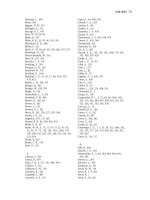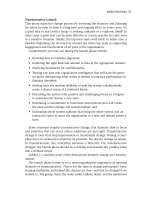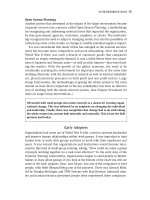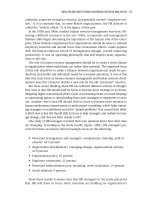Practicing Organization Development (A guide for Consultants) - Part 19 docx
Bạn đang xem bản rút gọn của tài liệu. Xem và tải ngay bản đầy đủ của tài liệu tại đây (162.14 KB, 10 trang )
Sectional Analysis Pooled Items Analysis
Final
Competence Name Competence Name # of items Competency
Representative Items
(# of items)
(# of items) in common Label
Keep the
Keep information 8 See the whole Quickly gr
asp the nature of the system
information flowing (7)
picture
Identify the boundary of systems to be changed
flowing (5)
Identify critical success factors for the intervention
Further clarify real issues
Set the conditions Think
Link change effort into ongoing organizational processes
for change (4) systemically (3)
Begin to lay out an evaluation model
Know how data from different parts of the system impact
Monitor the Be a quick
each other
environment for study (2)
Be aware of systems wanting to change
opportunities (4)
Monitor the
Set the conditions Collaboratively design the change pr
ocess
environment (1)
for positive change Clarify boundaries for confidentiality
Select a process that will facilitate openness
Create a non-threatening atmosphere
Develop mutually trusting relationships with others
Solicit feedback from others about your impact on them
Use information to reinforce positive change
Relevance (1) Focus on relevant 3 Focus on r
elevance Distill recommendations from the data
issues (5)
and flexibility Pay attention to the timing of activities
Maintain a flexible
Recognize what is relevant
focus (2)
Stay focused on the purpose of the consultancy
Continuously assess the issues as they surface
10_962384 ch05.qxd 2/3/05 12:01 AM Page 151
Table 5.4. Comparison of Competency Clusters
Sectional Analysis Pooled Items Analysis
Final
Competence Name Competence Name # of items Competency
Representative Items
(# of items)
(# of items) in common Label
Use evaluation to Data-driven
1 Use data to
Use information to correct negative change
adjust change (4) action (3)
adjust for change Use information to take next steps
Establish method to monitor change after the intervention
Use information to reinforce positive change
Gather data to identify initial first steps of transition
Develop
Set appropriate 5 Be available to
Collaborate with internal/external OD professionals
relationships (2) expectations (4)
multiple
Balance the needs of multiple relationships
stakeholders Listen to others
Apply effective
Interpersonally relate to others
Be available to IP skills (3)
Use humor effectively
multiple
Pay attention to the spontaneous and informal
stakeholders (7) Be mindful of
process (2)
Build realistic Build realistic expectations
relationships
Explicate ethical boundaries
Build trusting relationships
Good client
Good client
1 Good client
Match skills with potential client profile
choices (1)
choices (1)
choices
Clarify outcomes Clarify outcomes 1 Clarify
Clarify outcomes
and resources (3) (1)
outcomes
10_962384 ch05.qxd 2/3/05 12:01 AM Page 152
number of items that were common to both clusters and the final list of items
proposed to represent the competency concept. The final set of clusters includes
labels that are both specific to a phase of the planned change process as well
as generic skills that an OD practitioner should have. For example, the “keep
information flowing” competence ensures that communications should remain
open during all phases of the change process.
The final set of competencies consists of twenty-four clusters and 104 items.
Several competency clusters were nearly identical from the first analysis to the
second and were retained in their original form. This lends some confidence to
the integrity of the final proposed competencies. Clusters with good agreement
between both analyses include (1) self-mastery, (2) ability to evaluate change,
(3) ability to clarify data needs, (4) managing transition and institutionaliza-
tion, (5) integrating theory and practice, (6) staying current in technology, (7)
the ability to work with large systems, (8) participatively creating a good imple-
mentation plan, (9) understanding research methods, (10) managing diversity,
(11) clarifying roles, (12) addressing power, (13) keeping an open mind, (14)
managing client ownership of the change, (15) being comfortable with ambi-
guity, (16) managing the separation, and (17) focusing on relevance and flexi-
bility. In other words, more than half of the final competencies were reliably
formed in both analyses. Another five competencies emerged as combinations of
clusters from the two analyses.
DISCUSSION
The results from Table 5.4 allow us to address the two research questions
driving this chapter. First, is there any underlying structure within Sullivan’s
list of OD competencies? Second, what utility does the refined list have for OD
practitioners?
Underlying Structure of the Competencies
The data generated and analyzed in this study strongly support an underlying
structure in the Sullivan list of competencies. In both analyses, the data were
reduced to a smaller and more meaningful set of required skills and knowledge.
The final analysis suggests that twenty to twenty-four competencies adequately
describe the requirements of successful OD practitioners.
Utility of the Competencies
Finding an underlying structure within a list of 141 competencies is not all that
surprising. One of the primary purposes of factor analysis is to simplify and
reduce complex data sets into their essential themes. As a statistical bludgeon,
it has little trouble performing its task. The real issue is whether the proposed
COMPETENCIES OF OD PRACTITIONERS 153
10_962384 ch05.qxd 2/3/05 12:01 AM Page 153
structure has any more utility than other competency models or provides bet-
ter guidance to the field.
For this purpose, we compared our final competency list with the models
generated by Worley and Varney (1998), Worley and Feyerherm (2003), and
Shephard and Raia (1981). The Worley and Varney list was developed with sup-
port from the Academy of Management’s OD&C Division and therefore repre-
sents a primarily academic view. The Worley and Feyerherm list was derived
from interviews with veteran OD practitioners and researchers and therefore
represents the view of founders of the field. The Shephard and Raia list was
published in the early 1980s and therefore represents an historical baseline from
which to compare the development of the field. The four lists are compared in
Table 5.5.
Self-knowledge and self-awareness and understanding showed up in three of
the four competency studies. Only the academically oriented study did not
include self-awareness. The founders of the field and the early competency list
strongly supported self-understanding. That importance was reiterated in the
present study.
Consulting process competencies, especially competencies around the abil-
ity to diagnose and understand a system, design and execute interventions, and
work with large systems, were included in all of the lists. The competency of
managing the client’s development also is in this section because we see the
transferring of knowledge and skill from the OD practitioner to the client as a
part of the consulting process. This specific competency was a central value in
the early history of OD, but it isn’t included in Shephard and Raia’s list nor on
the competencies described by the founders of the field. It is included in the
academics’ list and has always been a core item in the development of Sullivan’s
list. It could easily be listed independently or included with other competency
categories, such as integrating theory and practice, and this classification war-
rants further discussion and research by the field. How important is the ability
to transfer knowledge and skill to the client, and what is its relationship to other
competencies?
All lists have competencies associated with academic knowledge and skills
in organization behavior, management, and organization theory as well as spe-
cific knowledge and skill in OD. The current study possesses one competency
within this category not found in any other list—the ability to stay current with
technology. Worley and Feyerherm specifically noted the lack of awareness and
mention of technology in their interviews with founders, and the academics do
not mention technology either, although one might argue it is implied under
the functional knowledge of business competence. In a related theme, three
of the four lists identified experience and knowledge about business as a com-
petence. Only Sullivan’s list contained no items related to this dimension. The
other three lists note that knowledge and experience represent sources of insight
into client issues and opportunities.
154 PRACTICING ORGANIZATION DEVELOPMENT, 2ND EDITION
10_962384 ch05.qxd 2/3/05 12:01 AM Page 154
Table 5.5. Comparison of Final Competencies with Other Competenc
y Studies
Final Competency List
Worley and Varney*
Worley and Feyerherm*
Shephard and Raia*
• Self-mastery
• Clear knowledge of self
Intrapersonal Skills
(including
• Being comfortable with
• Personal philosophies and integrity, staying in touch with
ambiguity
values; Ability to operate one’s own purpose and v
alues,
within values
active learning skills, rational-
emotive balance, and personal
stress management skills
• Managing transitions and • Managing the consulting
• Ability to design
General Consultation Skills
institutionalization
process
• Ability to deeply
(including entry and contracting,
• Participatively create a • Analysis and diagnosis
understand an
diagnosis, designing and executing
good implementation plan • Designing and choosing
organization
an intervention, and designing and
• Managing separation
appropriate and
managing large change processes)
• Managing client ownership relevant interventions
of change
• Facilitation and
• Setting the conditions
process consultation
for positive change
• Developing client
• Using data to adjust change capability
• Ability to work with
• Organization behavior • Large systems fluency
Organization Behavior/OD
large systems
(including culture, ethics, • Core knowledge about
Knowledge and Intervention Skills
• Staying current with
psychology, and leadership) the field
(including group dynamics (team
technology
• Group dynamics
building), OD theory, organization
• Management, organization
theory and design, open systems,
theory and design
reward systems, large system
• History of OD&C
change theory, leadership, power,
• Theories and models for
and sociotechnical analysis)
change
10_962384 ch05.qxd 2/3/05 12:01 AM Page 155
Table 5.5. Comparison of Final Competencies with Other Competenc
y Studies
Final Competency List
Worley and Varney*
Worley and Feyerherm*
Shephard and Raia*
• Ability to evaluate change • Research methods/statistics
• Evaluate and research
Research and Evaluation
• Ability to clarify data needs • Evaluating organization
• Developing new models
Knowledge and Skills/Research
• Understand research
change
of change and organization
Design/Data Collection/ Data
methods
Analysis
• Being available to listen to
• Interpersonal skills
Interpersonal Skills
(including
multiple stakeholders
• Ability to bring people listening, establishing trust and
• Building realistic
together
rapport, giving and receiving
relationships
• Consulting is saying the feedback, and counseling and
• Ability to work with
tough stuff
coaching)
and manage diversity
• Power and influence
• Ability to clarify roles
• Considering multiple
• Ability to work with power
viewpoints
• Ability to keep an open
mind
• Functional knowledge • Broad education, training,
Experience as a Line
of business
experience
Manager/Major Management
• Business orientation
Knowledge Areas
• Ability to see the
• System dynamics
• Ability to see systems
Collateral Knowledge Areas
whole picture
• Comparative cultural
(systems thinking)
(including behavioral sciences,
perspectives
• Cultural experience
systems analysis, R&D)
• Ability to integrate theory
• Theory and practice
and practice
• Focusing on relevant
• Able to focus on relevance
issues
and flexibility
• Clarifying outcomes
• Specific competencies
Presentation Skills
• Luck and timing
*Redundancies within the lists were eliminated and se
veral minor competencies were omitted. The Worley and V
arney list was divided into Foundational Knowledge
Competencies, Core Knowledge Competencies, and Cor
e Skill Competencies. The Worley and Feyerherm list consists of both curr
ent and future competencies.
10_962384 ch05.qxd 2/3/05 12:01 AM Page 156
All lists contain research methods competencies. Clearly, practitioners and
academics, both new and old alike, see the ability to use appropriate data col-
lection, analysis, and other design knowledge and skill as critical to the conduct
of OD.
As an applied behavioral science, OD has always been concerned with inter-
personal skills. As with the self-mastery competencies, the only group not
specifically mentioning interpersonal skills is the academic list. The competen-
cies in the current list are slightly richer in content and description than the
other two. Shephard and Raia’s list is very inclusive but somewhat generic, and
the Worley and Feyerherm list has a mix of generic and interpersonally charged
(for example, “consulting is saying the tough stuff”) competencies.
All four studies indicate that OD practitioners should have knowledge and
skills in collateral areas relevant to OD practice. Reflecting advancements in our
theories and knowledge about change, competencies related to systems think-
ing show up in all four studies, although in much more specific and central
ways in the three most recent competency studies. Similarly, the three most
recent studies, reflective of a strong globalization trend in business and society,
note the importance of working with diversity and having an appreciation of
cross-cultural differences.
The current study and the competencies noted by the founders of the field
suggest that OD practitioners be good at integrating, balancing, and applying
both theory and practice together as well as staying focused on the relevant
aspects of the change process. The academics and the early OD practitioners
did not raise issues of relevance and the integration of theory and practice.
CONCLUSIONS
Two initial conclusions are suggested by this comparison. First, the present com-
petency list is only marginally different from other lists, suggesting a certain
amount of convergent validity in our understanding of OD competencies and
providing a solid basis for recommending OD practitioner development. Sec-
ond, the relative stability in the competency list over the past twenty-five years
presents a challenge to the field to move forward.
Validity and Practitioner Development
The conclusion of convergence should be comforting to new entrants to the field or
to current practitioners looking for development guidance. For several years now,
fragmentation in the field and the lack of an agreed-on competency model have
frustrated OD students and practitioners looking to improve their skills. An emerg-
ing consensus represents a positive and hopeful sign. So where does one begin?
The statistical process used in this study has at least one practical benefit: It
orders the results in terms of their importance. Importance in this case means
COMPETENCIES OF OD PRACTITIONERS 157
10_962384 ch05.qxd 2/3/05 12:01 AM Page 157
that if an OD practitioner masters only the first competence, it will do more to
move that person toward effective OD practice than any other competence.
As shown in Table 5.3, self-mastery is the most important competence for an
OD practitioner to develop. Those familiar with the history and current state of
the field will recognize this as a controversial recommendation. Some OD prac-
titioners fear that giving personal growth and self-awareness such prominence
will return the field to the days of T-groups and sensitivity training. They would
be wrong, and their interpretation highlights one of the key reasons the field is
fragmented: Too many groups both inside and outside of OD confuse the tech-
nology of OD practice with the characteristics of effective practitioners.
Self-mastery is a competency, not an OD intervention. As an applied behav-
ioral science, OD values helping organizations and their members change,
increasing effectiveness, and improving the system’s capacity for future change
through people. It is grounded in theories of change and technologies of inter-
vention and is often facilitated by a practitioner, change agent, or consultant.
The practitioner’s position in relationship to the client system determines, in
part, the extent to which these valued outcomes are achieved. If practitioners
unconsciously position themselves as experts, inappropriately substitute self-
development for organization development, or create interventions they believe
the client “should” have, the likelihood of successful change, improved effec-
tiveness, or learning is diminished. Under these circumstances, criticisms of the
field are well-founded and lead, understandably, to a belief that OD is a “touchy
feely” process that is irrelevant to the strategic issues facing an organization.
This difficult task is a function of the practitioner’s self-knowledge, not the
change intervention; it is a role-modeling task carried out by the practitioner,
not the goal of the engagement.
Thus, self-mastery is the most important competency an OD practitioner can
have and, rather than a source of irrelevance, provides the basis for delivering
powerful results. Viewed not as an intervention in the system, but a character-
istic of the person doing the work, self-mastery allows the practitioner to access
and apply theories and models in a customized rather than a “canned” fashion;
to create with the client system a future it desires rather than one imposed on it;
to confront the client’s resistance or contribution to the current situation rather
than conspire with the client that it’s “other people’s” fault; to transfer knowl-
edge and skill to the client system rather than breed the client’s dependency; and
to ensure implementation responsibility rests with the client rather than believ-
ing the system has to be told what to do and how to do it. Customizing a change
management process to the client’s situation, focusing on implementation and
effectiveness, and thinking about helping the client to learn are the relevant
and practical results that derive from this most personal competency.
This conclusion does not give OD practitioners license to gather clients into
a circle to share feelings or to use coaching as a mask for therapy. It does say
158 PRACTICING ORGANIZATION DEVELOPMENT, 2ND EDITION
10_962384 ch05.qxd 2/3/05 12:01 AM Page 158
that every OD practitioner has the duty and responsibility to have an ongoing
personal growth plan and to engage in an appropriate course of personal and
professional development. The goal of such a plan is to become clearer about
their strengths and weaknesses, their psychological and behavioral idiosyn-
crasies, and their motivations for wanting to practice OD. For some that will
mean deep therapy; for others, a T-group experience will be amazingly insight-
ful; and for still others, journaling will represent a profound journey into self-
awareness. In fact, there are a variety of paths a practitioner can take to sharpen
his or her self as an instrument of change (Fletcher & Bailey, 2003; Peterson &
Hicks, 1996).
If the first recommendation about self-mastery was the most controversial, the
second recommendation—to develop the ability to apply research methods—is
surely the most surprising. Three of the top ten competencies in Table 5.3
are research related: the ability to evaluate change, to clarify data needs, and to
apply research methods appropriately. Although this competency was mentioned
in many prior competency lists, its importance in this list may reflect a recent
trend in the field. More client organizations are asking for project justification
and for evidence that OD processes will add value to the organization. The ability
to collect data appropriately, analyze and draw conclusions from that data, and
evaluate the effectiveness of change provides practitioners with a rationale and a
vocabulary to do so. It also represents an interesting counterpoint to the self-
mastery competence. The successful OD practitioner today must not only under-
stand the self, an admittedly intrapersonal and “soft” skill, but must balance that
skill with a cognitive, intellectual, and “hard” skill in research methods. The
rational and positivistic approach of statistical thinking aligns well with today’s
short-term, logical, and analytic cultures in many organizations.
A third and final recommendation for practitioner development is the most
obvious. OD practitioners must be competent in change management technolo-
gies. The competencies of managing the transition, keeping information flowing,
integrating theory and practice, working with large systems, and creating a good
action plan all speak to the ability to implement change. Curiously, diagnosis,
long a staple in the OD repertoire, did not specifically make the top ten list,
although “keep the information flowing” and “clarify data needs” were part of
the diagnostic section of the survey. Diagnostic competencies, although not
specifically identified as such, are thus not ignored in the list. Future revisers and
studies of this list might consider making diagnosis a more explicit competence.
These three competencies represent a starting point for practitioner develop-
ment. To assist readers in building their own personal and professional devel-
opment plans, an assessment tool, based on this research, is available at www.
RolandSullivan.com. Another can be found in Appendix I at the back of this
book. These competencies also can potentially serve as useful guidelines for
curriculum development and governance of the field.
COMPETENCIES OF OD PRACTITIONERS 159
10_962384 ch05.qxd 2/3/05 12:01 AM Page 159
Challenges to the Field
The second conclusion for this study is that the list of competencies challenges
the field to move forward. The results of this study suggest that there are about
twenty competencies of effective OD practitioners, and there is considerable
agreement about those competencies across studies, samples, and time. Some
competencies have evolved to reflect an increased understanding of human sys-
tems and the skills and knowledge necessary to change them according to a set
of values espoused by the field. Other competencies have remained relatively
stable over time, reflecting some of the more enduring aspects of OD practice
and philosophy.
The positive aspects of that result were discussed above. But this result
also challenges the field on two counts. First, if there is relatively good agree-
ment on the competencies, is more competency research necessary? Second,
if the competencies have not evolved dramatically, has the field matured or
stagnated?
To the first challenge, we propose restricting future OD competency work to
a more limited agenda. That is, there are a number of pressing issues facing the
field that warrant increased attention, including a better understanding of
the relationship between change and performance, better measures of change,
and more development and sharing of intervention technologies. Among the sug-
gestions for future research in the competency arena, we would support targeted
work in three areas. First, how are external trends, including technology, glob-
alization, and environmental sustainability, likely to affect OD competencies in
the future? The chapter by Eisen, Cherbeneau, and Worley in this book begins
that process, but it is worth expanding. Second, do OD practitioners differ in their
abilities in these areas and do those differences correlate with some measure of
practitioner effectiveness? This will be a difficult piece of research because it
requires that both successful and unsuccessful practitioners be identified. Third,
do competencies differ by the practitioner’s position? Are internal consultants
different from externals; do line managers differ from full-time OD practitioners;
and do international practitioners differ from domestic ones?
To the second challenge, the competencies reflect both a “forward to the
past” and a more integrated view of OD practice. The list is most similar to
Shepard and Raia’s (1981) list and may therefore reflect a more traditional view
of OD—some might say it’s an old paradigm view. We see it as an evolution.
The field began in the 1950s as part of the human relations influence in orga-
nization theory (Scott, 1981) and had a strong personal growth component. It
expanded in the 1970s and 1980s to embrace more content-oriented concerns
from work design, structure, and strategy. It moved away from its original
roots and in many ways has become a fragmented field (Church, 2001). The cur-
rent list therefore reasserts the roots of the field by noting the centrality of self-
mastery as a competence of effective OD practitioners, not an OD intervention,
160 PRACTICING ORGANIZATION DEVELOPMENT, 2ND EDITION
10_962384 ch05.qxd 2/3/05 12:01 AM Page 160









